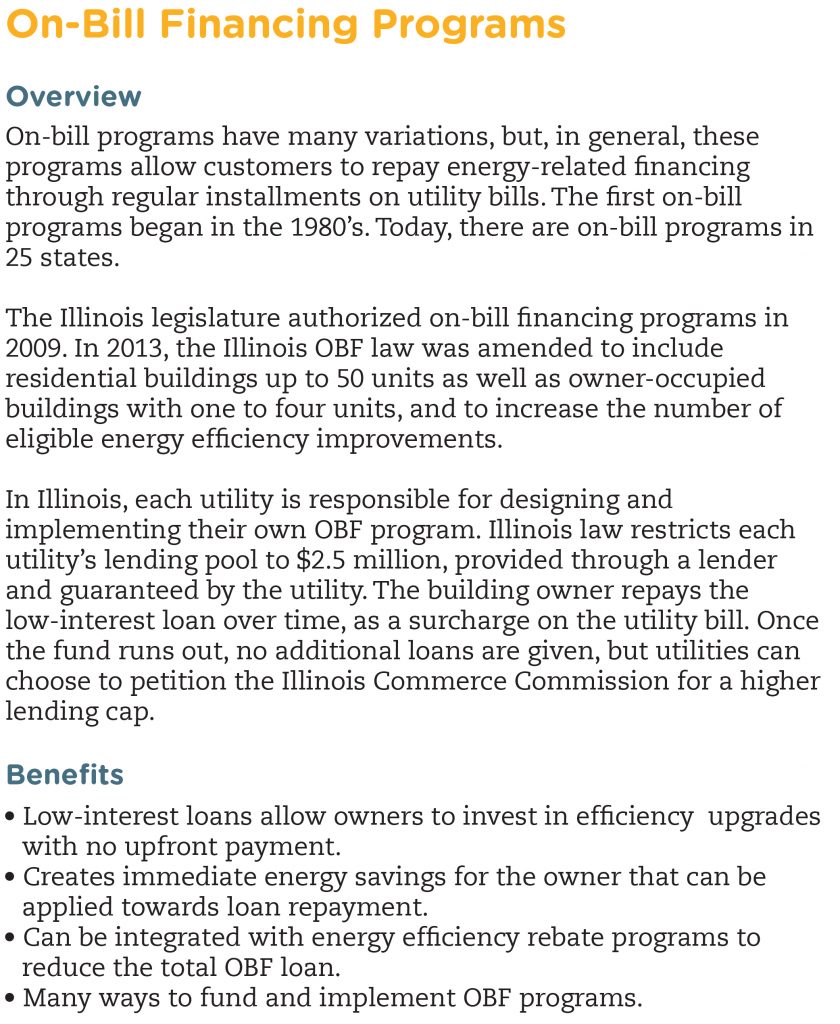How to Optimize On-Bill Financing to Help Illinois Building Owners Invest in Energy Efficiency
This post is written by Marcella Bondie Keenan, policy fellow at Elevate Energy.
Building owners can save money by investing in energy efficiency improvements. But if they can’t afford the upfront costs of the upgrades, they continue to pay higher energy bills and are even less able to pay for energy efficiency improvements down the road.
On-bill financing (OBF) is one tool to help owners break out of this cycle. It provides an opportunity to invest in energy efficiency through a loan that is repaid as a monthly installment on utility bills. However, current Illinois OBF programs exclude many utility customers because of restrictions on loan size, building types, and efficiency upgrades, as well as narrow definitions of credit worthiness. In this post, we identify several opportunities to create more effective on-bill financing programs in order to help more building owners invest in energy efficiency.
 Issue: Too Little Funding
Issue: Too Little Funding
By law, OBF programs in Illinois are capped at $2.5 million per utility. This funding cap is too low to satisfy customer demand. In fact, two utilities already reached the cap and petitioned for a higher cap in order to approve more loans. While the utilities waited for approval, their OBF programs were put on hold.
Solution: The funding cap for utilities’ OBF programs should be raised. A higher cap will lessen the number of times utilities must petition for an increase, shortening the wait for building owners who want to invest in energy efficiency.
Issue: Too Few Loan Approvals
OBF programs in Illinois currently exclude certain utility customers. For example, condominium owners can use OBF for in-unit efficiency upgrades, but condo associations are ineligible for financing. Because many condo associations have no assets other than reserve funds, they often find it challenging to finance large building expenses like whole-building energy efficiency improvements.
In addition, some utility customers are rejected from OBF programs because of narrow definitions of credit worthiness. According to one local utility’s evaluation of their OBF program, nearly half of all applicants are declined, primarily because they were unable to meet the 640 FICO score requirement.
Of course, it’s important to lend to owners who are likely to repay the loan. However, many OBF programs use utility bill payment history to determine credit worthiness, as it can be a good predictor of loan repayment. A recent report prepared by the Lawrence Berkeley National Laboratory for the U.S. Department of Energy found that of the 28 on-bill programs analyzed, Illinois was the only state to use traditional credit worthiness standards. However, programs with more relaxed standards had lower application rejection rates and a loan default rate of no higher than three percent. In fact, the report states, “Our analysis…yielded no obvious association between a program’s underwriting criteria and participant default rates.”
Solution: On-bill financing program administrators should follow the lead of other well-established programs around the country that have higher participation and low loan default rates. Illinois OBF programs should include condo associations and allow customers to use utility bill repayment history to qualify for financing.
Issue: Too Little Customer Choice
Illinois OBF programs restrict financing to energy efficiency upgrades that are part of a utility’s pre-approved Energy Efficiency Portfolio Standard programs. In fact, customers may only be able to choose from a very limited selection of energy efficiency products, rather than the most cost-effective and comprehensive improvements for their building. In addition, none of the OBF programs allow financing of maintenance issues that must be addressed before efficiency projects can be completed. For example, a leaky roof must be fixed before a building can be properly insulated.
Solution: OBF programs in Illinois should provide financing for any cost-effective energy efficiency improvement that is recommended by a qualified energy analyst, including any work needed to safely install it.
On-bill financing programs have been a great help to many of those who struggled to find the upfront money to invest in energy efficiency. According to Lawrence Berkeley National Laboratory, $1.83 billion has been lent over the lifetime of 30 on-bill programs. Financing has been used for improvements ranging from energy and water efficiency to renewable energy to health and safety. These programs have had more than 230,000 on-bill program participants with low default rates of between zero and three percent.
Refining Illinois OBF law and program design, will enable more building owners to participate and enjoy the benefits of energy efficiency, including lower energy bills and more comfortable homes. And, as we’ve written before, that will pay dividends for our local economy, our community, and our environment.
Additional Resources
- S. Department of Energy. “On-Bill Financing and Repayment Programs” http://energy.gov/eere/wipo/bill-financing-and-repayment-programs
- SEE Action Network Financing Solutions Working Group. “Financing Energy Improvements on Utility Bills: Market Updates and Key Program Design Considerations for Policymakers and Administrators” https://www4.eere.energy.gov/seeaction/publication/financing-energy-improvements-utility-bills-market-updates-and-key-program-design
- Federal Reserve Bank of San Francisco, Community Development Investment Review. “Financing Energy Efficiency Retrofits of Affordable Multifamily Buildings” http://www.frbsf.org/community-development/publications/community-development-investment-review/2014/march/financing-energy-efficiency-retrofits-affordable-multifamily-buildings/



